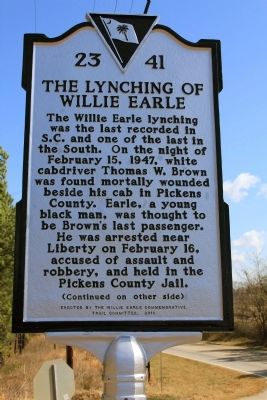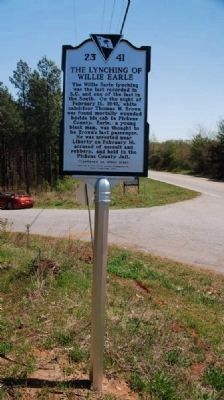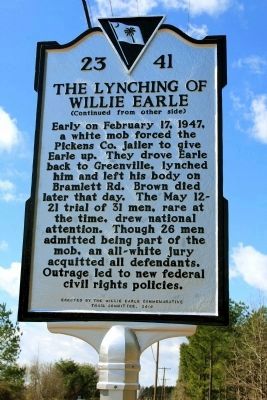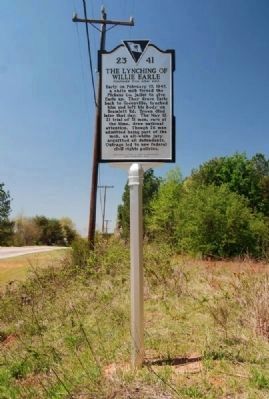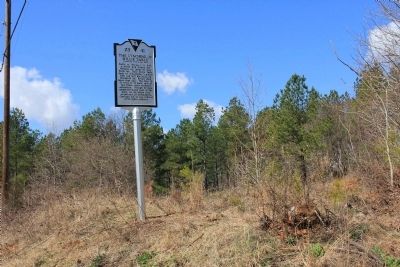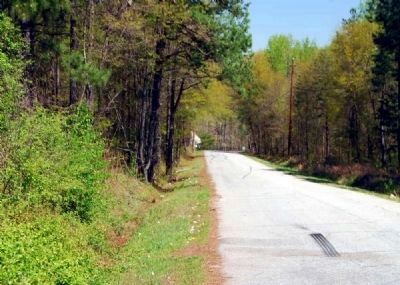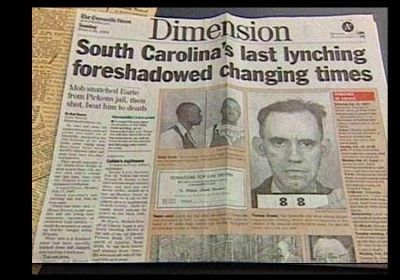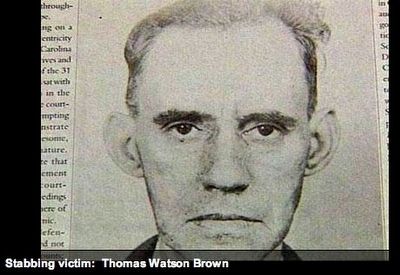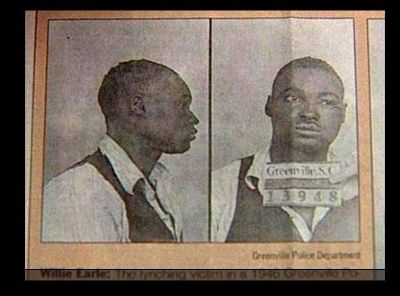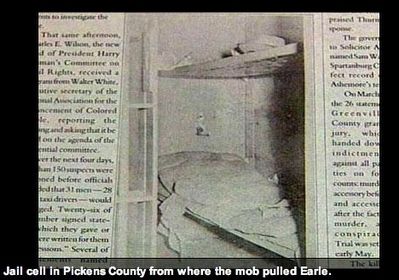Near Greenville in Greenville County, South Carolina — The American South (South Atlantic)
The Lynching Of Willie Earle
[Front]
The Willie Earle lynching was the last recorded in S.C. and one of the last in the South. On the night of February 15, 1947, white cabdriver Thomas W. Brown was found mortally wounded beside his cab in Pickens County. Earle, a young black man, was thought to be Brown’s last passenger. He was arrested near Liberty on February 16, accused of assault and robbery, and held in the Pickens County Jail.
[Reverse]
Early on February 17, 1947, a white mob forced the Pickens Co. jailer to give Earle up. They drove Earle back to Greenville, lynched him, and left his body on Bramlett Rd. Brown died later that day. The May 12-21 trial of 31 men, rare at the time, drew national attention. Though 26 men admitted being part of the mob, an all-white jury acquitted all defendants. Outrage led to new federal civil rights policies.
Erected 2010 by Willie Earle Commemorative Trail Committee. (Marker Number 23-41.)
Topics. This historical marker is listed in these topic lists: African Americans • Civil Rights. A significant historical date for this entry is February 15, 1826.
Location. Marker has been reported missing. It was located near 34° 50.692′ N, 82° 27.837′ W. Marker was near Greenville , South Carolina, in Greenville County. Marker was on Old Easley Highway (State Highway 124) near Bramlett Road (County Road 105), on the left when traveling north. Touch for map. Marker was in this post office area: Greenville SC 29611, United States of America. Touch for directions.
Other nearby markers. At least 10 other markers are within 3 miles of this location, measured as the crow flies. General Store (approx. 0.9 miles away); Dr. Harold B. Sightler (approx. 1.4 miles away); Woodside Mill (approx. 2 miles away); Parker High School Auditorium (approx. 2.4 miles away); Brandon Mill (approx. 2.6 miles away); Sterling High School (approx. 2.6 miles away); Mills Mill (approx. 2.6 miles away); Monaghan (approx. 2.6 miles away); Woodside (approx. 2.6 miles away); Piedmont (approx. 2.6 miles away). Touch for a list and map of all markers in Greenville.
More about this marker. This marker was stolen sometime in April, 2012. As of 2018 a group has raised the necessary funds to replace the marker and received approval from the state. The group is considering putting it in an area that is less rural than the Bramlett Road location so as not to be stolen again.
Regarding The Lynching Of Willie Earle. Yellow Cab driver Thomas W. Brown, a disabled veteran, had picked up a fare — at least one black male, by varying accounts — at about 9 p.m. on Markley Street for a run to the Liberty area in Pickens County, according to a 2003 analysis conducted by The Greenville News, which obtained FBI and local police investigation files. An hour later, Brown had been found alongside the old Liberty-Pickens road, bleeding after being robbed and stabbed three times. Police said footprints led from where Brown was found to the dilapidated Earle house a mile away, where police said they found some of the money taken from Brown and a bloodstained jacket and knife.
Shortly before dawn, Brown lay dying in a hospital as the group — all but three of them taxi drivers — decided to take Earle from the Pickens County jail after his arrest in Brown's killing. The taxi drivers' anger swelled at the West Court Street taxi office and cafe that faced each other behind the courthouse, a building that stands today near City Hall and the Westin Poinsett Hotel and was also the theater where the drivers' trial would play out on an international stage. They assembled at the Saluda River Bridge on what is now State 124.
A Pickens County jailer said he awoke to find a mob of men wearing mostly taxi driver caps and pointing guns at him with a demand to hand over Earle, which he did. An hour later, a black funeral home in Greenville received an anonymous call alerting where a body could be found on Bramlett Road, at the time an isolated, unpaved road. The 24-year-old Earle had been beaten and shot in the head with a shotgun.
The trial of the alleged conspirators attracted an international audience. The judge ruled that 26 confessions, each of them pointing blame at one another, couldn't be considered in the all-white jury's deliberations, which took five hours before a not-guilty verdict was handed down on all counts.
Related marker. Click here for another marker that is related to this marker.
Also see . . .
1. The Lynching of Willie Earle. Sixty-four years ago, the last lynching in South Carolina took place about 10-15 miles from where I live. (Submitted on May 11, 2011, by Brian Scott of Anderson, South Carolina.)
2. Scanned Copy of New York Times, February 18, 1947. Scroll down to view final two scans of the newspaper. (Submitted on May 11, 2011, by Brian Scott of Anderson, South Carolina.)
Additional commentary.
1. Comments from Time Magazine's Coverage of the Lynching
...Somebody "pulled the Negro out of the car by his belt." The drivers "hit him several times with their fists and knocked him to the ground." One of the drivers pulled out a knife. "Before you kill him," he said, "I want to put the same scars on him that he put on Brown." Said Jessie Lee Sammons: "I could hear the tearing of clothing and flesh."
Then the drivers "beat the side of his head with a shotgun." Said Marvin H. Flemming's statement: "I could hear some licks like they were pounding on him with the butt end of a gun. I heard the Negro say, 'Lord, you done killed me.' " Finally, said Charlie Covington, he heard Roosevelt Carlos Hurd Sr., a Blue Bird cab driver, cry out: "Give me the gun and let's get this over with." Just then, "a tall, slender boy with bushy hair hit the Negro in the mouth and knocked him down. The Negro started to get up when Mr. Hurd took the shotgun. He shot the Negro in the head. He unloaded the gun and called for more shells...Mr. Hurd shot the Negro two more times." The tissue of Willie Earle's brain was left hanging on the bushes. The lynchers went back to Greenville and drank coffee...
— Submitted May 11, 2011, by Brian Scott of Anderson, South Carolina.
Credits. This page was last revised on November 17, 2020. It was originally submitted on February 25, 2011, by David Bullard of Seneca, South Carolina. This page has been viewed 16,690 times since then and 246 times this year. Photos: 1. submitted on February 25, 2011, by David Bullard of Seneca, South Carolina. 2. submitted on May 11, 2011, by Brian Scott of Anderson, South Carolina. 3. submitted on February 25, 2011, by David Bullard of Seneca, South Carolina. 4. submitted on May 11, 2011, by Brian Scott of Anderson, South Carolina. 5. submitted on February 25, 2011, by David Bullard of Seneca, South Carolina. 6. submitted on May 11, 2011, by Brian Scott of Anderson, South Carolina. 7, 8, 9, 10. submitted on February 25, 2011, by David Bullard of Seneca, South Carolina. • Bill Pfingsten was the editor who published this page.
